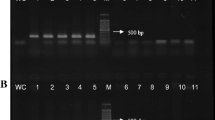Abstract
The field symptoms of Eradu patch are distinct, stunted patches in narrow-leaf lupin and ill-thrift patches in barley. The pathogen, a thin, binucleate Rhizoctonia (TBR), is difficult to isolate with standard methods. To develop an assay specific to TBR, the ribosomal RNA ITS region was amplified and a 610 bp section including the conserved 5.8S region was sequenced. This sequence did not match any published sequence. Primers specific to TBR were constructed. The specificity of the assay was confirmed using 104 isolates of TBR obtained from many sites in Western Australia. Tests against R. solani AG 8 and other fungi commonly isolated from lupin and barley roots were negative. TBR was detected in all roots from artificially infected lupin and barley, but detection of TBR in root samples collected from field patches in 1997 was low (0–15%). New methods for extracting the TBR DNA, including the use of soil immersion plates, enabled detection of TBR (80–100%) in field samples collected in 1999. The PCR assay developed is a reliable technique for the detection of TBR in field samples and will provide an effective tool for diagnostics and the conduct of field surveys.
Similar content being viewed by others
References
Ainsworth GC (1968) ‘Plant pathologist's pocketbook.’ (The Commonwealth Mycological Institute, CAB: Kew, Surrey, England)
Barry T, Colleran G, Glennon M, Dunican LK, Gannon F (1992) The 16S/23S ribsomal spacer region as a target for DNA probes to identify eubacteria. PCR Methods and Applications 1, 51–56.
Brisbane PJ, Neate SM, Pankhurst CE, Scott NS, Thomas MR (1995) Sequence-tagged site markers to identify Rhizoctonia solani AG 4 or 8 infecting wheat in South Australia. Phytopathology 85, 1423–1427.
Carling DE, Rothrock CS, MacNish GC, Sweetingham MW, Brainard KA, Winters SW (1994) Characterization of Anastomosis Group 11 (AG-11) of Rhizoctonia solani. Phytopathology 84, 1387–1393.
Cooke DEL, Duncan JM (1997) Phylogenetic analysis of Phytophthora species based on ITS1 and ITS2 sequences of the ribosomal RNA gene repeat. Mycological Research 106, 667–677.
Dobrowolski MP, O'Brien PA (1993) Use of RAPD-PCR to isolate a species specific DNA probe for Phytophthora cinnamomi. FEMS Microbiology Letters 113, 43–47.
Don RH, Cox PT, Wainwright BJ, Baker K, Mattick JS (1991) ‘Touchdown’ PCR to circumvent spurious priming during gene amplification. Nucleic Acids Research 19, 4008.
Hoist-Jensen A, Köln LM, Schumacher T (1997) Nuclear rDNA phylogeny of the Sclerotiniaceae. Mycologia 89, 885–899.
Johnston CG, Aust SD (1994) Detection of Phanerochaete chrysosporium in soil by PCR and restriction enzyme digestion. Applied and Environmental Microbiology 60, 2350–2354.
Kreader CA (1996) Relief of amplification inhibition in PCR with bovine serum albumin or T4 Gene 32 protein. Applied and Environmental Microbiology 62, 1102–1106.
Kuninaga S, Natsuaki T, Takeuchi T, Yokosawa R (1997) Sequence variation of the rDNA ITS regions within and between anastomosis groups in Rhizoctonia solani. Current Genetics 32, 237–243.
MacLeod WJ (2001) Eradu patch of Lupinus angustifolius: effects of fungicides in vitro on the causal Rhizoctonia sp. and on the root disease in the field. Australasian Plant Pathology 30, 239–243.
MacLeod WJ, Sweetingham MW (1997) A root disease of Lupinus angustifolius caused by a new species of binucleate Rhizoctonia. Australian Journal of Agricultural Research 48, 21–30.
MacNish GC, Neate SM (1996) Rhizoctonia bare patch of cereals. An Australian perspective. Plant Disease 80, 965–971.
MacNish GC, O'Brien PA (2003) The thin, binucleate Rhizoctonia causing Eradu patch is widespread in lupin and cereal crops in Western Australia. Australasian Plant Pathology 32, 299–304.
MacNish GC, Sweetingham MW (1993) Evidence of stability of pectic zymogram groups within Rhizoctonia solani AG-8. Mycological Research 97, 1056–1058.
Niepold F, Schober-Butin B (1995) Application of the PCR technique to detect Phytophthora infestons in potato tubers and leaves. Microbiological Research 159, 379–385.
Raeder U, Broda P (1985) Rapid preparation of DNA from filamentous fungi. Letters in Applied Microbiology 1, 17–20.
Robb H, Hu X, Platt H, Nazar R (1994) PCR based assays for the detection and quantification of Verticillium species in potato. In ‘Modern assays for plant pathogenic fungi: identication, detection and quantification’. (Eds A Schots, FM Dewey, R Oliver) pp. 83–90. (CAB International: Wallingford)
Sweetingham MW, Cruickshank RH, Wong DH (1986) Pectic zymograms and taxonomy and pathogenicity of the Ceratobasidiaceae. Transactions of the British Mycological Society 86, 305–311.
Trevors JT (1992) DNA extraction from soil. Microbial Releases 1, 3–9.
Vogelstein B, Gillespie D (1979) Preparative and analytical purification of DNA from agarose. Proceedings of the National Academy of Sciences of the United States of America 76, 615–619.
Whisson DL, Herdina, Francis L (1995) Detection of Rhizoctonia solani AG-8 in soil using a specific DNA probe. Mycological Research 99, 1299–1302.
White TJ, Bruns T, Lee J (1990) Amplification and direct sequencing of fungal ribosomal RNA genes for phylogenetics. In ‘PCR protocols’. (Eds DH Gelfand, JJ Sninsky, TJ White) pp. 315–321. (Academic Press: New York)
Author information
Authors and Affiliations
Corresponding author
Rights and permissions
About this article
Cite this article
MacNish, G.C., O'Brien, P.A. Development of a PCR assay for detection of the thin, binucleate Rhizoctonia causing Eradu patch disease of lupin and barley. Australasian Plant Pathology 32, 289–297 (2003). https://doi.org/10.1071/AP03030
Received:
Accepted:
Issue Date:
DOI: https://doi.org/10.1071/AP03030




